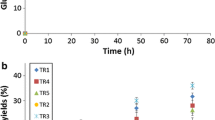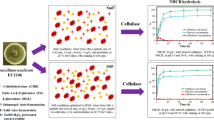Abstract
Compared to Trichoderma reesei RUT-C30 cellulase (Trcel), Penicillium oxalicum 16 cellulase (P16cel) from the fermentation supernatant produced a 2-fold higher glucose yield when degrading microcrystalline cellulose (MCC), possessed a 10-fold higher β-glucosidase (BGL) activity, but obtained somewhat lower other cellulase component activities. The optimal temperature and pH of β-1,4-endoglucanase, cellobiohydrolase, and filter paperase from P16cel were 50–60 °C and 4–5, respectively, but those of BGL reached 70 °C and 5. The cellulase cocktail of P16cel and Trcel had a high synergism when solubilizing MCC and generated 1.7-fold and 6.2-fold higher glucose yields than P16cel and Trcel at the same filter paperase loading, respectively. Additional low concentration of fructose enhanced the glucose yield during enzymatic hydrolysis of MCC; however, additional high concentration of monosaccharide (especially glucose) reduced cellulase activities and gave a stronger monosaccharide inhibition on Trcel. These results indicate that P16cel is a more excellent cellulase than Trcel.





Similar content being viewed by others
References
Tiquia-Arashiro, S. M., & Mormile, M. (2013). Sustainable technologies: bioenergy and biofuel from biowaste and biomass. Environmental Technology, 34, 1637–1638.
Zhang, Y., Li, Q., Su, J., Lin, Y., Huang, Z., Lu, Y., Sun, G., Yang, M., Huang, A., Hu, H., & Zhu, Y. (2015). A green and efficient technology for the degradation of cellulosic materials: structure changes and enhanced enzymatic hydrolysis of natural cellulose pretreated by synergistic interaction of mechanical activation and metal salt. Bioresource Technology, 177, 176–181.
Zhao, X., Wang, W., & Wei, D. (2013). Identification of Petriella setifera LH and characterization of its crude carboxymethyl cellulase for application in denim Biostoning. Journal of Microbiology, 51, 82–87.
Percival Zhang, Y. H., Himmel, M. E., & Mielenz, J. R. (2006). Outlook for cellulase improvement: screening and selection strategies. Biotechnology Advances, 24, 452–481.
Andrić, P., Meyer, A. S., Jensen, P. A., & Dam-Johansen, K. (2010). Reactor design for minimizing product inhibition during enzymatic lignocellulose hydrolysis: I. Significance and mechanism of cellobiose and glucose inhibition on cellulolytic enzymes. Biotechnology Advances, 28, 308–324.
Gusakov, A. V. (2011). Alternatives to Trichoderma reesei in biofuel production. Trends in Biotechnology, 29, 419–425.
Saini, R., Saini, J. K., Adsul, M., Patel, A. K., Mathur, A., Tuli, D., & Singhania, R. R. (2015). Enhanced cellulase production by Penicillium oxalicum for bio-ethanol application. Bioresource Technology, 188, 240–244.
Chen, M., Qin, Y., Liu, Z., Liu, K., Wang, F., & Qu, Y. (2010). Isolation and characterization of a β-glucosidase from Penicillium decumbens and improving hydrolysis of corncob residue by using it as cellulase supplementation. Enzyme and Microbial Technology, 46, 444–449.
Castellanos, O. F., Sinitsyn, A. P., & Vlasenko, E. Y. (1995). Comparative evaluation of hydrolytic efficiency toward microcrystalline cellulose of Penicillium and Trichoderma cellulases. Bioresource Technology, 52, 119–124.
Anbar, M., & Bayer, E. A. (2012). Approaches for improving thermostability characteristics in cellulases. Methods in Enzymology, 510, 261–271.
Wu, I., & Arnold, F. H. (2013). Engineered thermostable fungal Cel6A and Cel7A cellobiohydrolases hydrolyze cellulose efficiently at elevated temperatures. Biotechnology and Bioengineering, 110, 1874–1883.
Chen, H., Hayn, M., & Esterbauer, H. (1992). Purification and characterization of two extracellular β-glucosidases from Trichoderma reesei. Biochimica et Biophysica Acta, Protein Structure and Molecular Enzymology, 1121, 54–60.
Igarashi, K., Uchihashi, T., Koivula, A., Wada, M., Kimura, S., Okamoto, T., Penttila, M., Ando, T., & Samejima, M. (2011). Traffic jams reduce hydrolytic efficiency of cellulase on cellulose surface. Science, 333, 1279–1282.
Jagtap, S. S., Dhiman, S. S., Kim, T. S., Li, J., Lee, J. K., & Kang, Y. C. (2013). Enzymatic hydrolysis of aspen biomass into fermentable sugars by using lignocellulases from Armillaria gemina. Bioresource Technology, 133, 307–314.
Jalak, J., Kurašin, M., Teugjas, H., & Väljamäe, P. (2012). Endo-exo synergism in cellulose hydrolysis revisited. The Journal of Biological Chemistry, 287, 28802–28815.
Resch, M. G., Donohoe, B. S., Baker, J. O., Decker, S. R., Bayer, E. A., Beckham, G. T., & Himmel, M. E. (2013). Fungal cellulases and complexed cellulosomal enzymes exhibit synergistic mechanisms in cellulose deconstruction. Energy & Environmental Science, 6, 1858–1867.
Hsieh, C. W. C., Cannella, D., Jørgensen, H., Felby, C., & Thygesen, L. G. (2014). Cellulase inhibition by high concentrations of monosaccharides. Journal of Agricultural and Food Chemistry, 62, 3800–3805.
Vlasenko, E. Y., Ding, H., Labavitch, J. M., & Shoemaker, S. P. (1997). Enzymatic hydrolysis of pretreated rice straw. Bioresource Technology, 59, 109–119.
Mandels, M., Hontz, L., & Nystrom, J. (1974). Enzymatic hydrolysis of waste cellulose. Biotechnology and Bioengineering, 16, 1471–1493.
Miller, G. L. (1959). Use of dinitrosalicylic acid reagent for determination of reducing sugar. Analytical Chemistry, 31, 426–428.
Gao, D., Chundawat, S. P., Krishnan, C., Balan, V., & Dale, B. E. (2010). Mixture optimization of six core glycosyl hydrolases for maximizing saccharification of ammonia fiber expansion (AFEX) pretreated corn stover. Bioresource Technology, 101, 2770–2781.
Bradford, M. M. (1976). A rapid and sensitive method for quantitation of microgram quantities of protein utilizing the principle of protein-dye binding. Analytical Biochemistry, 72, 248–254.
Zhao, X., Wang, W., Wang, F., & Wei, D. (2012). A comparative study of β-1,4-endoglucanase (possessing β-1,4-exoglucanase activity) from Bacillus subtilis LH expressed in Pichia pastoris GS115 and Escherichia coli Rosetta (DE3). Bioresource Technology, 110, 539–545.
Cheng, Y., Song, X., Qin, Y., & Qu, Y. (2009). Genome shuffling improves production of cellulase by Penicillium decumbens JU-A10. Journal of Applied Microbiology, 107, 1837–1846.
Yao, G., Li, Z., Gao, L., Wu, R., Kan, Q., Liu, G., & Qu, Y. (2015). Redesigning the regulatory pathway to enhance cellulase production in Penicillium oxalicum. Biotechnology for Biofuels, 1, 1–17.
Martins, L. F., Kolling, D., Camassola, M., Dillon, A. J. P., & Ramos, L. P. (2008). Comparison of Penicillium echinulatum and Trichoderma reesei cellulases in relation to their activity against various cellulosic substrates. Bioresource Technology, 99, 1417–1424.
Pimentel, P. S. R., de Souza, A. L., Nascimento, A. T. R., de Andrade, E. V., Astolfi-Filho, S., & Nunes-Silva, C. G. (2014). Endo and exoglucanases produced by Penicillium citrinum isolated from Amazon. BMC Proceedings, 8, 179.
de Castro, A. M., de Carvalho, M. L. D. A., Leite, S. G. F., & Pereira, N., Jr. (2010). Cellulases from Penicillium funiculosum: production, properties and application to cellulose hydrolysis. Journal of Industrial Microbiology & Biotechnology, 37, 151–158.
Camassola, M., De Bittencourt, L. R., Shenem, N. T., Andreaus, J., & Dillon, A. J. P. (2004). Characterization of the cellulase complex of Penicillium echinulatum. Biocatalysis and Biotransformation, 22, 391–396.
Ramani, G., Meera, B., Vanitha, C., Rao, M., & Gunasekaran, P. (2012). Production, purification, and characterization of a β-glucosidase of Penicillium funiculosum NCL1. Applied Biochemistry and Biotechnology, 167, 959–972.
Gao, L., Gao, F., Wang, L., Geng, C., Chi, L., Zhao, J., & Qu, Y. (2012). N-glycoform diversity of cellobiohydrolase I from Penicillium decumbens and synergism of nonhydrolytic glycoform in cellulose degradation. The Journal of Biological Chemistry, 287, 15906–15915.
Wood, T. M., McCRAE, S. I., & Bhat, K. M. (1989). The mechanism of fungal cellulase action. Synergism between enzyme components of Penicillium pinophilum cellulase in solubilizing hydrogen bond-ordered cellulose. Biochemical Journal, 260, 37–43.
Jørgensen, H., Vibe-Pedersen, J., Larsen, J., & Felby, C. (2007). Liquefaction of lignocellulose at high solids concentrations. Biotechnology and Bioengineering, 96, 862–870.
Kristensen, J. B., Felby, C., & Jørgensen, H. (2009). Yield-determining factors in high-solids enzymatic hydrolysis of lignocellulose. Biotechnology for Biofuels, 2, 11.
Felby, C. (2014). Water as a hydrolysis substrate: cellulase inhibition at high dissolved solids content // 36th Symposium on Biotechnology for Fuels and Chemicals.
Acknowledgments
This work was supported by the National Basic Research Program of China (973, Program NO.2012CB721103), National High Technology Research and Development Program of China (863, Program NO.2012AA101806), National Natural Science Foundation of China (31360217), and Doctoral Starting up Foundation of Jiangxi Normal University (5451).
Author information
Authors and Affiliations
Corresponding authors
Rights and permissions
About this article
Cite this article
Zhao, Xh., Wang, W., Tong, B. et al. A Newly Isolated Penicillium oxalicum 16 Cellulase with High Efficient Synergism and High Tolerance of Monosaccharide. Appl Biochem Biotechnol 178, 173–183 (2016). https://doi.org/10.1007/s12010-015-1866-x
Received:
Accepted:
Published:
Issue Date:
DOI: https://doi.org/10.1007/s12010-015-1866-x




